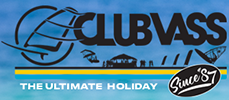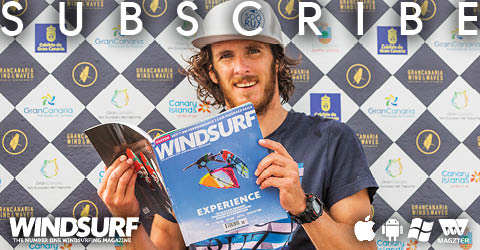CHARGE OF THE NEW BRIGADE
115L SLALOM BOARD TEST 2017
Test Editor Tris Best // Second Testers Maurin Rottenwalter & Joe North
Photos Andy Stallman // Test location Portland Harbour, Dorset
The cream of the crop, slalom boards are the elite racing machines of the windsurfing world, but does that make them challenging to sail? The test team reviewed a selection of the latest and fastest slalom boards on the market today with some very interesting results. Read on to find out their findings.
This test was originally published in the August 2017 issue.
The concept of slalom is intrinsic within the DNA of an adrenaline sport such as windsurfing. As soon as the ascendancy of planing conditions and ‘fun-boarding’ was realised, the next obvious step was to push the speed barrier and the limit of what was possible in a straight-line.
Next came the desire to race your peers, so mark out a course where each leg is on the fastest point of sail possible … and the birth of slalom windsurfing has arrived! The only slight caveat to this format as opposed to all-out speed is that the racers need to go round corners – something that the board designers of the early to mid-nineties almost exclusively seemed to ignore. In a ‘first past the post’ format, the designers still decided that outright speed was the area in which they could gain most advantage over their rivals. Boards were ballistically fast, but technical to sail well and nigh on impossible to get through the turn with any sort of grace unless you fully committed. Today, we’re pleased to say there has been some level of clarity in this area; a change of approach has occurred. Don’t get us wrong – these boards are still incredibly fast. They continue to accelerate with every gust … and yet a degree of discipline has been installed. The boards seem to thrive on the challenge, rather than trying to kick the rider off like a bucking bronco. And the same can be said in the gybe – the boards enter in control and exit with speed. Just like the old proverb of counting pennies and collecting pounds – if control is maintained whatever the conditions, speed and race results will follow.
FINDINGS
By embarking upon reading this test, you may be looking for some indication as to which board is fastest. Surely speed is a quantitative quality, so we can be quite definitive with the answer? We’d like to think so too! The truth is though that all these boards are fast. Very fast. In the right hands, they are all race winners, full stop. We conducted this test over a good number of months, trying the boards in everything from mirror flat water to horrid corrugated chop and rolling swell. And the fact is that all of these boards had their day where they came out on top! The secret is in the detail – setting the board up for the conditions, choosing the right fin size, placing the deck-plate in the correct position to achieve the right balance. Partnering and tuning the correct sail for the board … and of course setting up for your own personal riding style. There are just so many permutations.
Regarding fins, we used a variety throughout the test, from 36 cm to 40 cm and mostly F-Hots (many thanks to Kev Greenslade for the loan). For the mast-track position, we have been reliably informed that the vast majority of the most successful slalom sailors in the world start with the track at 135 cm and to a large extent leave it at this point. So we did the same – start there and moved it incrementally according to the balance we discovered. And so to the biggest finding of the test. We made reference to it earlier, but it is certainly worth stating again: the modern slalom board is surprisingly controllable. Of course, it will take a little getting used to if you step off a freeride platform and straight onto one of these. And you have to make sure you partner it with a powerful enough engine to keep up. But fundamentally, it has been realised that you’re going to win races if you get round the course in one piece!
This makes these boards well within reach of the experienced rider that loves to be analytical. That is not to say they are dumbed down. Far from it. These boards benefit from rider input and interpretation. For example, all the fin boxes with these boards (with the exception of RRD) are placed between 80 mm – 82 mm from tail. This makes the feedback from the fin increasingly sensitive, particularly when blasting around and the fin’s area counts for a large percentage of the total area still in contact with water! So if you are a ‘weekend warrior’ and just want to go for a hassle-free hack, these boards are wasted on you. (You would also save yourself some considerable money by looking at the freeride/freerace sector, where the board comes supplied WITH a fin!). But if you like to charge around, trying to get the most from your kit, then look no further. Perhaps you’re a GPS speed-sailing fan? Or an aspiring slalom racer that has a passion for beating your friends and anyone else on the water for that matter? Then this type of platform is right up your alley.
SUMMARY
The six boards here are all thoroughbreds, but with subtle differences in their characters. Let’s start with the Fanatic. With masses of heritage in the slalom field, this new 114 is a flighty exciting prospect that sets your hair alight in light marginal winds, yet still has the temperament to deliver when the chips are down. By contrast, the house of Goya enters the slalom scene for the first time this year, and their offering of the Proton 116 is a fantastic first foray, with real ease to its ability. RRD and Tabou are similarly much more refined this year, championing control in challenging conditions. The X-Fire is incredibly smooth, helped by its bottom shape and thick pads, whilst the Manta always feels as if it is backing you, particularly in its glide through the gybe. The JP Slalom 71 is a lively beast, which initially backs you into a defensive or combative stance. Ultimately we found that this is counterproductive and the board benefits from you taking a more relaxed approach. The same can be said of the Starboard iSonic. In the ultra lightweight Reflex Carbon technology we tested the 107 in, it is so alert, it feels on-edge and nervous. But learn to trust it and you begin to feel invincible around the speed park. Whichever board you choose, investing in spending time on the water to discover its full potential and sweet spot cannot be underestimated.
THE LINE UP
• STARBOARD ISONIC 107 REFLEX CARBON




